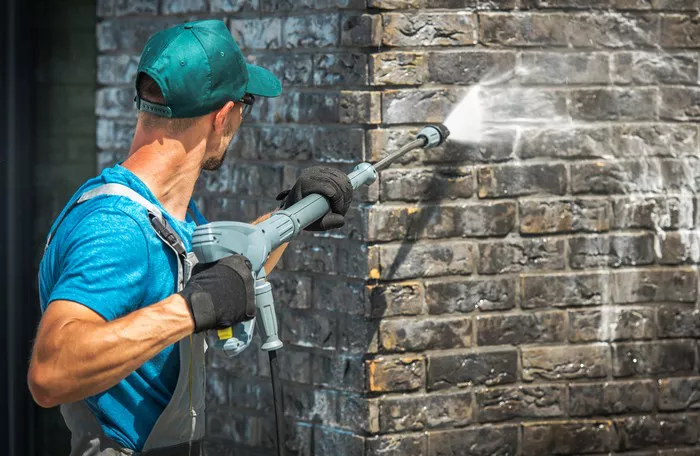Pressure washing is a powerful cleaning method utilized to remove dirt, grime, mildew, and other debris from various surfaces. It involves using a high-pressure water spray to dislodge and wash away unwanted substances. This process is highly effective in preparing surfaces for painting as it ensures a clean, smooth, and properly primed surface, thus enhancing paint adhesion and longevity.
Benefits for Pre-painting Surface Preparation:
1. Deep Cleaning: Pressure washing penetrates deep into surface pores, eliminating embedded dirt and contaminants that can hinder paint adhesion.
2. Efficiency: It is a time-saving method compared to manual scrubbing or chemical cleaning, allowing for faster surface preparation.
3. Environmental Friendliness: Pressure washing typically requires only water and does not rely on harsh chemicals, making it an environmentally friendly option.
Importance of Drying Time:
After pressure washing, allowing sufficient drying time is crucial before applying paint. Failure to do so can result in a range of issues, including poor paint adhesion, blistering, and uneven finish. Proper drying time ensures that the surface is completely free of moisture, enabling the paint to adhere properly and form a durable bond.
Emphasizing Crucial Drying Time:
1. Adhesion: Moisture trapped beneath the paint can prevent proper adhesion, leading to paint failure and premature peeling.
2. Uniformity: Painting on a wet surface can cause the paint to spread unevenly, resulting in an inconsistent finish.
3. Longevity: Adequate drying time ensures that the paint cures properly, contributing to its durability and longevity.
Factors Affecting Drying Time:
Several factors influence the drying time after pressure washing, making it imperative to consider these variables before proceeding with painting.
Weather Conditions:
1. Humidity: High humidity prolongs drying time as moisture in the air slows down evaporation from the surface.
2. Temperature: Warmer temperatures facilitate faster drying, whereas colder temperatures impede the evaporation process.
Material Porosity:
1. Absorbency: Porous materials such as wood or concrete absorb water more readily, necessitating a longer drying period.
2. Surface Texture: Rough surfaces retain moisture longer than smooth surfaces, affecting drying time accordingly.
Type of Paint:
1. Water-based Paints: These paints typically dry faster than oil-based alternatives, but still require adequate drying time to ensure proper adhesion.
2. Primer: Applying a primer before painting can help seal the surface and reduce drying time by providing a stable base for the paint.
General Timeframe:
While drying times may vary depending on the aforementioned factors, a general guideline is to wait at least 24 hours after pressure washing before painting. However, it’s essential to assess the specific conditions of the surface and environment to determine the optimal drying time.
Signs of Readiness:
To determine if the surface is dry and ready for painting, consider the following indicators:
1. Visual Inspection: Check for any visible signs of moisture, such as water droplets or dampness on the surface.
2. Texture: The surface should feel dry to the touch, without any residual moisture or tackiness.
3. Color: Wet surfaces may appear darker than dry areas, so ensure uniformity in color before proceeding with painting.
Potential Problems:
Painting too soon after pressure washing can lead to several issues that compromise the quality and longevity of the paint job.
Paint Adhesion:
1. Peeling: Moisture trapped beneath the paint film prevents proper adhesion, leading to peeling and flaking over time.
2. Blistering: The presence of moisture can cause bubbles or blisters to form on the painted surface, detracting from its aesthetic appeal.
Uneven Finish:
1. Staining: Painting on a wet surface can result in paint stains or streaks, creating an uneven and unattractive finish.
2. Mold and Mildew Growth: Moist conditions provide an ideal environment for mold and mildew growth, leading to unsightly blemishes on the painted surface.
Tips for Different Surfaces:
Each type of surface requires specific considerations to ensure optimal drying and paint adhesion.
Wood:
1. Sealants: Apply a wood sealer or primer to seal the surface and minimize moisture absorption.
2. Drying Time: Allow extra drying time for wood surfaces, as they tend to retain moisture longer than other materials.
Concrete:
1. Sealing: Consider applying a concrete sealer to protect the surface and facilitate faster drying.
2. Efflorescence: Address any efflorescence (white powdery deposits) on the concrete surface before painting to prevent paint adhesion issues.
Siding:
1. Cleaning Agents: Use mild detergents or specialized siding cleaners to remove stubborn stains and dirt before pressure washing.
2. Surface Inspection: Inspect the siding for any signs of damage or deterioration that may affect paint adhesion.
Maintenance Tips:
To maintain the integrity of the painted surface and prolong its lifespan, follow these maintenance practices:
1. Regular Inspection: Periodically inspect the painted surface for any signs of damage, wear, or moisture intrusion.
2. Cleaning: Clean the surface regularly using gentle cleaners and avoid harsh abrasives or chemicals that may damage the paint.
3. Repairs: Promptly address any cracks, chips, or peeling paint to prevent further deterioration and maintain the appearance of the surface.
Conclusion
In conclusion, allowing sufficient drying time after pressure washing is essential for ensuring the success of a paint job. By considering various factors such as weather conditions, material porosity, and type of paint, and following proper drying guidelines, you can achieve a durable and aesthetically pleasing finish that enhances the overall appearance of the surface. Regular maintenance practices further contribute to the longevity and performance of the painted surface, ensuring its continued beauty and protection against the elements.

